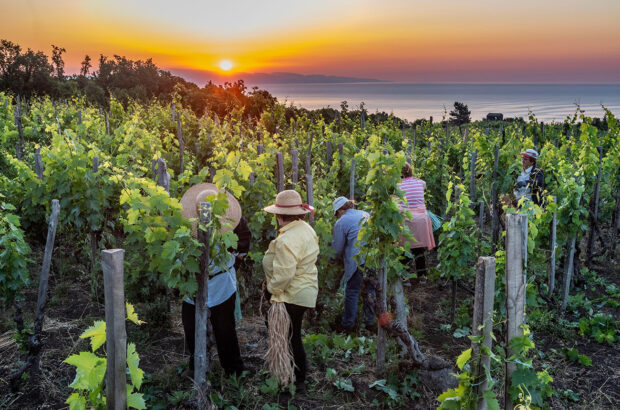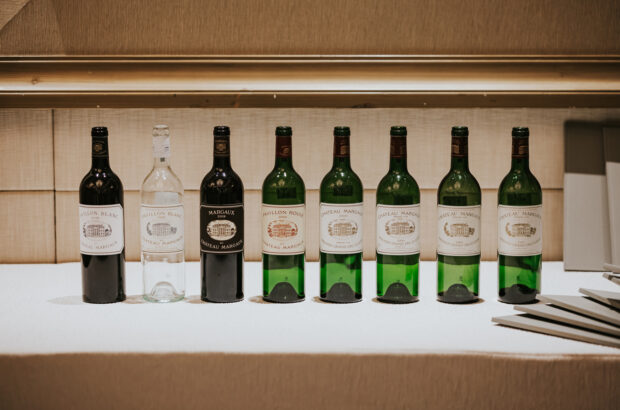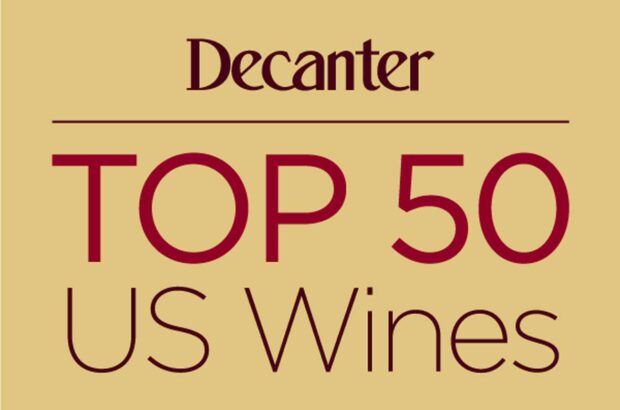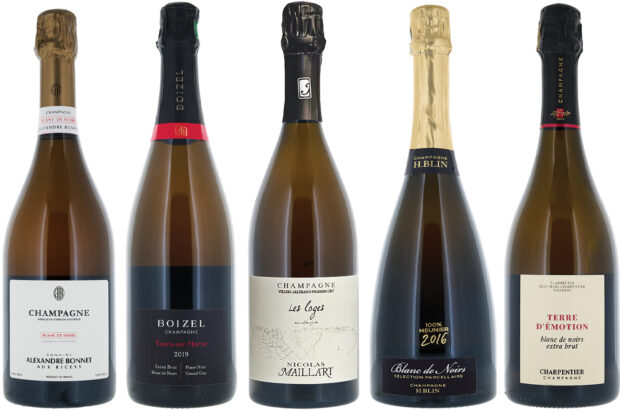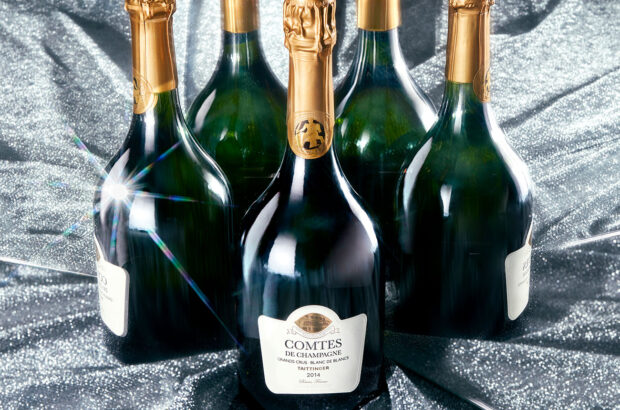The Left Bank may have the most prestigious châteaux, but the Right Bank’s been getting all the plaudits. So which has more influence on the other, asks Margaret Rand.
When Alain Raynaud, consultant winemaker to numerous Right Bank properties, says, ‘We’re more peasant on the Right Bank,’ it’s hard to know whether to take him seriously. There he is in his immaculately cut tweed jacket and a tie that probably came from Hermès, looking like a wealthy landowner at a Sunday drinks party. What he means is, of course, that he and his fellow Right Bank winemakers get their hands dirty. Whereas the Left Bank consists of châteaux worthy of the name – large, imposing and turreted, and very often owned by big, wealthy companies, big, wealthy families or zillionaires not from the wine world – on the Right Bank, the term ‘château’ is more likely to be a figure of speech than an architectural description, and the owner will live on the premises rather than in Paris.
Left Bank properties can be 50ha–80ha (hectares) or more; on the Right Bank, 5ha is pretty normal; 10ha substantial; 30ha exceptional. And yet these Right Bank serfs, supposedly with earth under their fingernails from toiling in their few miserable hectares day and night, are making the running in Bordeaux – sky-high prices are asked for wines that appear from nowhere, and names you’ve never heard of are now getting 98 points from Robert Parker. The spotlight has shifted, and you could be forgiven for thinking that a shadowy chill has fallen on the echoing salons of the Left Bank, as the millionaires struggle to catch up, struggle to copy the peasants across the river. For the first time, there is a sentiment that the Right Bank is exerting more of an influence on the Left Bank than vice versa.
So is it a revolution?
If it is, it started nearly 30 years ago. In 1979, Jacques Thienpont, together with his father and his uncle, bought a single hectare of gravel, sand and clay in Pomerol, and called the resulting wine Le Pin. Its success was not immediate; only in the 1990s did it start achieving the sort of prices that made headlines. In 1991, it was followed by Valandraud (2.5ha), in 1996 by La Mondotte (4.3ha) and Le Dôme (1.72ha): garage wines had arrived. And everything else instantly looked old-fashioned.
{"content":"PHA+VGhlIHJlYXNvbnMgd2h5IGdhcmFnZSB3aW5lcyBoYXBwZW5lZCBvbiB0aGUgUmlnaHQgQmFuayByYXRoZXIgdGhhbiB0aGUgTGVmdCBoYXZlIGJlZW4gd2VsbCByZWhlYXJzZWQsIGFuZCBmb2N1cyBtYWlubHkgb24gdGhlIGxvd2VyIHByaWNlIG9mIGxhbmQgdGhlcmUuIEl0IHdhcyByZWxhdGl2ZWx5IGVhc3kgYXQgdGhlIHRpbWUgdG8gZmluZCBhbiBhZmZvcmRhYmxlIHBhcmNlbCBpbiBTdC1FbWlsaW9uIGFuZCwgaWYgaXQgd2FzbuKAmXQgdGhhdCBncmVhdCwgdG8gbWFrZSB1cCBmb3IgaXRzIHNob3J0Y29taW5ncyBieSBleHRyZW1lbHkgbG93IHlpZWxkcywgc3VwZXIgY29uY2VudHJhdGlvbiBhbmQgc3VwZXIgZXh0cmFjdGlvbi4gQSByZXR1cm4gdG8gYWdlLW9sZCwgYXJ0aXNhbmFsIG1ldGhvZHMgd2FzIG9mdGVuIGFsc28gZGljdGF0ZWQgYnkgbGFjayBvZiBjYXNoIGFuZCB0aGUgc21hbGwgc2NhbGUgb2YgdGhlIG9wZXJhdGlvbi48L3A+CjxwPlN1Y2ggd2luZSBjYXVnaHQgdGhlIFBhcmtlciB3YXZlOiB0aGUgaW5mbHVlbmNlIG9mIGhpcyBwYWxhdGUgaGFzIGJlZW4gY3J1Y2lhbCBpbiB0aGUgcmlzZSBvZiB0aGUgUmlnaHQgQmFuayDigJMgYXMgaGFzIGhpcyBmcmllbmRzaGlwIHdpdGggY29uc3VsdGFudCBNaWNoZWwgUm9sbGFuZCwgd2l0aCB0aGUgbGF0dGVy4oCZcyBlbm9ybW91cyBleHBlcnRpc2UgaW4gY29heGluZyB0aGUgYmVzdCBvdXQgb2YgTWVybG90IHZpYSBsYXRlIHBpY2tpbmcgYW5kIHVsdHJhLWx1c2ggdGV4dHVyZXMuIEdhcmFnaXN0ZXMsIFBhcmtlciBhbmQgUm9sbGFuZCB3ZXJlIGFuIHVuYmVhdGFibGUgdHJpbml0eTogZ3Jvd2VycyBhY3Jvc3MgdGhlIHJpdmVyIGNvdWxkIG9ubHkgZ2F3cCBpbiBlbnZ5LiBCdXQgbm93IGV2ZXJ5b25lIHNheXMgdGhhdCBnYXJhZ2UgaXMgZGVhZC48L3A+CjxwPlNvIGhhcyBwb3dlciByZXR1cm5lZCB0byB0aGUgTGVmdCBCYW5rPyBOby4gRXZlcnl0aGluZyBpbiBtb2Rlcm4gQm9yZGVhdXggd2luZW1ha2luZywgYWNjb3JkaW5nIHRvIFJheW5hdWQg4oCTIGxvd2VyIHlpZWxkcywgc3RyaWN0IHNvcnRpbmcgb2YgZ3JhcGVzLCBjb2xkIGZlcm1lbnRhdGlvbiDigJMgc3RhcnRlZCwgYXMgQW5nw6lsdXPigJkgSHViZXJ0IGRlIEJvw7xhcmQgdGVzdGlmaWVzLCBvbiB0aGUgUmlnaHQgQmFuay4gVGhlIHJlYXNvbj8gVGhlIGVzdGF0ZXMgYXJlIHNtYWxsZXIgYW5kIGl04oCZcyBlYXNpZXIgdG8gZG8uPC9wPgo8ZGl2IGNsYXNzPSJhZC1jb250YWluZXIgYWQtY29udGFpbmVyLS1tb2JpbGUiPjxkaXYgaWQ9InBvc3QtaW5saW5lLTMiIGNsYXNzPSJpcGMtYWR2ZXJ0Ij48L2Rpdj48L2Rpdj4KPHA+4oCYQXQgTGFzY29tYmVzIFt0aGUgTcOpZG9jIGNow6J0ZWF1IHdoZXJlIFJheW5hdWQgd2FzIGNvbnN1bHRhbnRdLCB0aGV5IHNhaWQgSSBjb3VsZG7igJl0IGRvIHRoZXNlIHRoaW5ncyBiZWNhdXNlIGl0IHdhcyB0b28gYmlnLCBidXQgSSBkaWQuIEFuZCBNZXJsb3Qgd2FzIGFsd2F5cyBsZXNzIGltcG9ydGFudCBvbiB0aGUgTGVmdCBCYW5rLiBJdCBjYW1lIGZyb20gdGhlIFJpZ2h0IEJhbmsgYW5kIG5vdyBpdOKAmXMgNDAl4oCTNTAlIG9mIHRoZSBMZWZ0IEJhbmsgdmluZXlhcmQuIEl0IHNob3dzIGJldHRlciB3aGVuIHlvdW5nIGFuZCBpdCBjYW4gYWdlLuKAmTwvcD4KPHA+VGhlIFJpZ2h0IEJhbmsgc2hvd2VkIHRoYXQgdGhlIHdvcmxkIHdhbnRlZCByaWNobmVzcywgcmlwZW5lc3MgYW5kIGNvbmNlbnRyYXRpb24sIGFuZCBieSBkb2luZyBzbywgc2V0IHRoZSBhZ2VuZGEgZm9yIG1vZGVybiBjbGFyZXQuIFRoZSBMZWZ0IEJhbmsgaGFzIGNlcnRhaW5seSBmb2xsb3dlZC4gTWVybG90IGhhcyBpbmNyZWFzZWQgdGhlcmUsIG5vdCBsZWFzdCBiZWNhdXNlIHRoZSBzYWxlYWJpbGl0eSBvZiBhIHZpbnRhZ2UgaXMgZGV0ZXJtaW5lZCBpbml0aWFsbHkgYnkgdGhlIGVuIHByaW1ldXIgdGFzdGluZ3MgZWFjaCBzcHJpbmcsIGFuZCBpZiB5b3VyIHdpbmUgbG9va3MgbGVhbiBhbmQgbWVhbiBhdCB0aGF0IHN0YWdlIHlvdSB3b27igJl0IGJlIGFibGUgdG8gY2hhcmdlIHNvIG11Y2ggZm9yIGl0LjwvcD4KPGRpdiBjbGFzcz0iYWQtY29udGFpbmVyIGFkLWNvbnRhaW5lci0tbW9iaWxlIj48ZGl2IGlkPSJwb3N0LWlubGluZS00IiBjbGFzcz0iaXBjLWFkdmVydCI+PC9kaXY+PC9kaXY+CjxwPkJ1dCBnYXJhZ2Ugd2luZXMgbmV2ZXIgaGFwcGVuZWQgb24gdGhlIExlZnQgQmFuaywgZGlkIHRoZXk\/IFdlbGwsIHRoZXJl4oCZcyBNYXJvamFsbGlhIGluIE1hcmdhdXgsIGxhdW5jaGVkIGluIDE5OTkgYW5kIG1hZGUgdW5kZXIgdGhlIGF1c3BpY2VzIG9mIE11cmllbCBBbmRyYXVkLCB3aWZlIG9mIFN0LUVtaWxpb24gZ2FyYWdpc3RlIEplYW4tTHVjIFRodW5ldmluLiBBbmQgdGhlcmXigJlzIEhhdXQtQ29uZGlzc2FzLCBmcm9tIGEgZ3JhdmVsbHkgcGF0Y2ggb2YgdmluZXMgYXQgUm9sbGFuZC1kZS1CeTsgUmF5bmF1ZCBjb25zdWx0cyBoZXJlLjwvcD4KPHA+QmVybmFyZCBNYWdyZXogYWxzbyBtYWtlcyB2YXJpb3VzIG1pY3JvLWN1dsOpZXMgb24gdGhlIExlZnQgQmFuayDigJMgTGEgU2Vydml0dWRlIFZvbG9udGFpcmUsIExhIFPDqXLDqW5pdMOpLCBNYWdyZXogVGl2b2xpIOKAkyBidXQgSSBzZWxkb20gaGVhciB0aGVtIHRhbGtlZCBhYm91dC4gTm8gZG91YnQgdGhleSBzZWxsIGluc3RhbnRseSB0byBNYWdyZXogY3VzdG9tZXJzLiBCb3RoIE1hcm9qYWxsaWEgYW5kIEhhdXQtQ29uZGlzc2FzIGhhdmUgd29uIHBsYXVkaXRzIGFsdGhvdWdoLCB0byBteSBwYWxhdGUsIE1hcm9qYWxsaWEgZG9lc27igJl0IHRhc3RlIGxpa2UgTWFyZ2F1eC4gQm90aCwgeW91IG5vdGljZSwgYXJlIG1hZGUgd2l0aCBSaWdodCBCYW5rIGFkdmljZSwgYW5kIHRoZXnigJlyZSBub3QgdGhlIG9ubHkgTGVmdCBCYW5rIHByb3BlcnRpZXMgdG8gYmUgYnJpbmdpbmcgaW4gaGlnaC1jbGFzcyBtZXJjZW5hcmllcyBmcm9tIHRoZSBvdGhlciBzaWRlLiBSaWdodCBCYW5rZXIgU3TDqXBoYW5lIERlcmVub25jb3VydCBjb25zdWx0cyBmb3IgU21pdGgtSGF1dC1MYWZpdHRlIGFuZCBhIGhhbmRmdWwgb2Ygb3RoZXJzIGluIFBlc3NhYy1Mw6lvZ25hbjsgUm9sbGFuZCBjYW4gYmUgZm91bmQgYXQgUGjDqWxhbi1Tw6lndXIsIExvdWRlbm5lLCBMYXNjb21iZXMsIEzDqW92aWxsZS1Qb3lmZXJyw6ksIFBvbnRldC1DYW5ldCwgU21pdGgtSGF1dC1MYWZpdHRlLCBNYWxhcnRpYy1MYWdyYXZpw6hyZSwgUGFwZSBDbMOpbWVudCBhbmQgb3RoZXJzOyBkZSBCb8O8YXJkIGNvbnN1bHRzIGF0IFBpY2hvbi1MYWxhbmRlIGFuZCBvdGhlcnMuPC9wPgo8ZGl2IGNsYXNzPSJhZC1jb250YWluZXIgYWQtY29udGFpbmVyLS1tb2JpbGUiPjxkaXYgaWQ9InBvc3QtaW5saW5lLTUiIGNsYXNzPSJpcGMtYWR2ZXJ0Ij48L2Rpdj48L2Rpdj4KPHA+QnV0IHRoaXMgaXMgbm90IGEgbGlzdCBvZiBNZXJsb3Qgd2FubmFiZXMuIFNtaXRoLUhhdXQtTGFmaXR0ZSwgZm9yIGV4YW1wbGUsIGhhcyBubyB3aXNoIHRvIGVtdWxhdGUgU3QtRW1pbGlvbjogeWVzLCB0aGV54oCZdmUgcGxhbnRlZCBzb21lIE1lcmxvdCB3aGVyZSB0aGVyZSB3YXMgQ2FiZXJuZXQgU2F1dmlnbm9uIGJlZm9yZSwgYnV0IHRoZXnigJl2ZSBzaW1wbHkgbW92ZWQgdGhlIENhYmVybmV0IGFjcm9zcyB0aGUgcm9hZCwgd2hlcmUgaXTigJlzIHdhcm1lci4gTm9yIGlzIFBpY2hvbi1MYWxhbmRlLCB0aGF0IG1vc3QgZWxlZ2FudGx5IGZlbWluaW5lIG9mIFBhdWlsbGFjcywgYWJvdXQgdG8gdHVybiBpbnRvIGEgbXVzY3VsYXIgcHJpemVmaWdodGVyLiBCb8O8YXJkIGRlc2NyaWJlcyBoaXMgd29yayB0aHVzOjwvcD4KPHA+4oCYT24gdGhlIFJpZ2h0IEJhbmssIHdlIGNhbiB0cmVhdCBhIHZpbmV5YXJkIGxpa2UgYSBnYXJkZW47IHByb3BlcnRpZXMgYXJlIHNtYWxsLiBPbiB0aGUgTGVmdCBCYW5rLCB0aGV54oCZcmUgYmlnZ2VyLCBidXQgSSB0cnkgdG8gYmUgbW9yZSBwcmVjaXNlIGluIHRoZSB2aW5leWFyZCBpbiB0ZXJtcyBvZiByaXBlbmVzcywgdGhvdWdoIG5vdCBhcyBmYXIgYXMgb3ZlcnJpcGVuZXNzIGluIE1lcmxvdC4gVGhlIHJpc2sgb2Ygb3ZlcnJpcGVuZXNzIGluIENhYmVybmV0IFNhdXZpZ25vbiBpcyBub3RoaW5nOyBJIGhhdmUgbmV2ZXIgZm91bmQgYW4gb3ZlcnJpcGUgQ2FiZXJuZXQuIFNvIEkgdHJ5IHRvIHB1c2ggdGhlIHJpcGVuZXNzLiBJIGhhdmUgZ3JlYXQgcmVzcGVjdCBmb3IgdGhlIHRlcnJvaXIgb2YgdGhlIExlZnQgQmFuazsgSSBqdXN0IHdhbnQgdG8gZ2V0IGdyZWF0ZXIgZXhwcmVzc2lvbiBvZiB0aGUgdGVycm9pci7igJk8L3A+CjxwPkxpbGlhbmUgQmFydG9uIG9mIEzDqW92aWxsZS1CYXJ0b24gc2F5czog4oCYTm90IG1hbnkgb24gdGhlIExlZnQgQmFuayBmb2xsb3dlZCB0aGUgUmlnaHQgQmFuayB0byBleHRyZW1lIGx1c2huZXNzIGFuZCBjb25jZW50cmF0aW9uLiBJbiAxOTk4IGFuZCAxOTk5LCB0aGUgUmlnaHQgQmFuayB3YXMgZ2V0dGluZyBoaWdoIHByaWNlcyBhbmQgdGhlIExlZnQgQmFuayB3YXMgYSBiaXQgamVhbG91cywgYnV0IHdlIG5ldmVyIGhhZCB0aGUgY29uY2VwdCBvZiBmb2xsb3dpbmcgdGhlaXIgaWRlYXMu4oCZPC9wPgo8cD5EaWQgcGVvcGxlIG9uIHRoZSBMZWZ0IEJhbmsgbmV2ZXIgdGhpbmsgYWJvdXQgZ2FyYWdlIHdpbmVzPyDigJhGcm9tIDNhbSB0byAzLjA1YW0gb25lIG1vcm5pbmcgd2hlbiBJIGNvdWxkbuKAmXQgc2xlZXAs4oCZIHNoZSBzYWlkLiDigJhHYXJhZ2Ugd2luZXMgYXJlIGFuIGFic3RyYWN0aW9uOiB5b3UgY2FuIHJlYWQgYWJvdXQgdGhlbSBidXQgeW91IGNhbuKAmXQgZmluZCB0aGVtIGluIHRoZSBzaG9wcywgc28geW91IGNhbuKAmXQgdGFzdGUgdGhlbS4gRXZlbiBpZiBnYXJhZ2Ugd2luZXMgaGFkIHN1Y2NlZWRlZCwgdGhlIExlZnQgQmFuayBwcm9iYWJseSB3b3VsZG7igJl0IGhhdmUgY29waWVkIHRoZW0gYmVjYXVzZSBvZiB0aGUgdm9sdW1lIHdlIHByb2R1Y2Uu4oCZPC9wPgo8cD5UaGF04oCZcyBhbm90aGVyIGNydWNpYWwgZGlmZmVyZW5jZSB0aGF0IGtlZXBzIHRoZSB0d28gc2lkZXMgYXBhcnQ6IHRoZSBMZWZ0IEJhbmsgaGFzIGEgbG90IG1vcmUgd2luZSB0byBzaGlmdC4gRmV3IHByb3BlcnRpZXMgY2FuIGFmZm9yZCB0byBiZSBzZWVuIHRvIGJlIGNyZWFtaW5nIG9mZiB0aGUgdG9wIHZhdHMgaW50byBhIHN1cGVyLWN1dsOpZSwgYmVjYXVzZSB0aGUgcmVzdCBvZiB0aGUgd2luZSB3b3VsZCBpbnN0YW50bHkgYmUgZGlmZmljdWx0IHRvIHNlbGwuIFRoZXnigJl2ZSBnb3Qgcm91bmQgdGhlIHByb2JsZW0gYnkgcHV0dGluZyBsZXNzIHdpbmUgaW50byB0aGUgZ3JhbmRzIHZpbnMgYW5kIG11Y2ggbW9yZSBpbnRvIHRoZSBzZWNvbmQgd2luZXM6IGluIDIwMDUsIGZvciBleGFtcGxlLCBDaMOidGVhdXggTWFyZ2F1eCBhbmQgTGFmaXRlIGNvbnRhaW5lZCBqdXN0IDQwJSBvZiB0aGVpciByZXNwZWN0aXZlIHRvdGFsIGNyb3BzLCBhbmQgSGF1dC1CcmlvbiBhbmQgTGF0b3VyIHdlcmUgNDUlLiBNb3V0b24gYnVja2VkIHRoZSB0cmVuZCB3aXRoIDY0JS48L3A+CjxwPkZvciBSaWdodCBCYW5rIG93bmVycyB0byBnbyB0aGUgd2hvbGUgaG9nIGFuZCBidXkgcHJvcGVydGllcyBvbiB0aGUgTGVmdCBCYW5rIGlzIHVzdWFsbHkgc2VlbiBhcyBtb3JlIGRpZmZpY3VsdDogYmVpbmcgYmlnZ2VyLCB0aGV5IGFyZSBnZW5lcmFsbHkgcmF0aGVyIGV4cGVuc2l2ZS4gQnV0IGl0IGRvZXMgaGFwcGVuOiB0aGUgQ3V2ZWxpZXIgZmFtaWx5LCBvd25lcnMgb2YgQ2xvcyBGb3VydGV0IGluIFN0LUVtaWxpb24sIGhhdmUgYm91Z2h0IFBvdWplYXV4IGluIE1vdWxpcy4gVGhlIG1vbmV5IGNhbiBhbHNvIHRyYXZlbCBpbiB0aGUgb3RoZXIgZGlyZWN0aW9uOiBBWEEgTWlsbMOpc2ltZXMsIG93bmVyIG9mIFBpY2hvbi1Mb25ndWV2aWxsZSBhbW9uZyBvdGhlciBwcm9wZXJ0aWVzLCBhbHNvIG93bnMgUGV0aXQtVmlsbGFnZSBpbiBQb21lcm9sLiBCZXJuYXJkIE1hZ3JleiBvd25zIHByb3BlcnRpZXMgb24gYm90aCBiYW5rcywgbm90YWJseSBQYXBlIENsw6ltZW50IGluIFBlc3NhYy1Mw6lvZ25hbiBhbmQgRm9tYnJhdWdlIGluIFN0LUVtaWxpb24uIFBhcGUgQ2zDqW1lbnQgaGFzIGJlY29tZSBhIG11c2N1bGFyIHdpbmUgdW5kZXIgdGhlIE1hZ3JleiBpbmZsdWVuY2UsIHZlcnkgZGlmZmVyZW50IHRvIGl0cyBmb3JtZXIsIGVsZWdhbnQsIHNlZHVjdGl2ZSBjaGFyYWN0ZXIuIFBlcmhhcHMgaGUgd291bGQgbm90IGFncmVlIHdpdGggTWF0dGhpZXUgQ3V2ZWxpZXIgd2hvIHNheXM6IOKAmFdoYXTigJlzIGV4cGVjdGVkIGZyb20gdGhlIFJpZ2h0IEJhbmsgaXMgZGlmZmVyZW50IHRvIHdoYXTigJlzIGV4cGVjdGVkIGZyb20gdGhlIExlZnQgQmFuazsgdGhlIGxldmVsIG9mIGNvbmNlbnRyYXRpb24gaXMgZGlmZmVyZW50LuKAmSBBbmQgaGUgd291bGQgcHJvYmFibHkgYWxzbyBkaXNhZ3JlZSB3aXRoIExpbGlhbmUgQmFydG9uIHdoZW4gc2hlIHNheXM6IOKAmEEgZmV3IHllYXJzIGFnbywgdGhlIGZhc2hpb24gd2FzIHRvIGhhdmUgZmFzaGlvbmFibGUgd2luZTsgbm93IHRoZSBmYXNoaW9uIGlzIHNwZWNpZmljaXR5IGluIHdpbmU7IHBlcnNvbmFsaXR5LiBUaGF04oCZcyBub3cgdGhlIGZhc2hpb24gb24gdGhlIExlZnQgQmFuay4gQW5kIG9uIHRoZSBSaWdodCBCYW5rIGl04oCZcyBiZWNvbWluZyBtb3JlIHNvLuKAmTwvcD4KPHA+PHN0cm9uZz5UaGVyZeKAmXMgYSBjaGFuZ2UgZm9yIHlvdTo8L3N0cm9uZz4gdGhlIExlZnQgQmFuayBpbmZsdWVuY2luZyB0aGUgUmlnaHQgQmFuay4gSXMgaXQgcmVhbGx5IGhhcHBlbmluZz8gQWxhaW4gUmF5bmF1ZCBkZW5pZXMgdGhhdCB0aGUgTGVmdGlzdHMgZXZlciBpbmZsdWVuY2UgdGhlIFJpZ2h0aXN0cyDigJMg4oCYZXhjZXB0IGZvciB0aGUgcmVwdXRhdGlvbiBvZiB0aGUgdmludGFnZS4gVGhleSBwcm9kdWNlIG1vcmUgdGhhbiB1cy4gU28gaWYgdGhlIHZpbnRhZ2UgaXMgc3VjY2Vzc2Z1bCBpbiB0aGUgTcOpZG9jLCBpdCB3aWxsIGJlIHNhaWQgdG8gYmUgc3VjY2Vzc2Z1bCBhbGwgb3ZlciBCb3JkZWF1eC7igJk8L3A+CjxwPkJ1dCBpZiBvbmUgbG9va3MgYXQgdGhlIHdpbmVzIHByb2R1Y2VkIGluIFN0LUVtaWxpb24gYW5kIFBvbWVyb2wgb3ZlciB0aGUgcGFzdCBmZXcgeWVhcnMsIG9uZSBzZWVzIGh1Z2UgZXh0cmFjdGlvbiBpbiB0aGUgZmlyc3QgeWVhcnMgb2YgdGhpcyBjZW50dXJ5IOKAkyB2ZXJ5IHRhbm5pYywgY2hld3kgd2luZXMgdGhhdCBhcmUgaGFyZCBnb2luZyB3aGVuIHlvdW5nLiBCdXQgdGhlbiBpbiAyMDA1LCB0aGV5IHNlZW1lZCBhIGxvdCBmcmllbmRsaWVyIGluIHlvdXRoLCBwZXJoYXBzIGJlY2F1c2Ugb2YgdGhlIGdsb3Jpb3VzIHNpbGtpbmVzcyBhbmQgcGVyZnVtZSBvZiB0aGUgdmludGFnZS4gQW5kIGluIDIwMDYsIGEgeWVhciBvZiBwb3RlbnRpYWxseSBiaWcsIGRyeSB0YW5uaW5zLCB0aGUgUmlnaHQgQmFuayBzZWVtZWQgdG8gaGF2ZSB0YWtlbiBpdHMgZm9vdCBvZmYgdGhlIHBlZGFsOiBzdWRkZW5seSwgdGhlIHdpbmVzIHdlcmUgbG9va2luZyBtb3JlIGJhbGFuY2VkIHRoYW4gdGhleSBoYWQgYmVlbiBmb3IgeWVhcnMuPC9wPgo8cD7igJhCb3JkZWF1eCBpcyBtb3JlIGNsYXNzaWNhbCBub3cgdGhhbiAxMCB5ZWFycyBhZ28s4oCZIGNvbmZpcm1zIFBhdHJpY2sgQmVybmFyZCBvZiBuw6lnb2NpYW50IE1pbGzDqXNpbWE7IOKAmGl04oCZcyBhYm91dCBiYWxhbmNlIGFuZCBlbGVnYW5jZSByYXRoZXIgdGhhbiBleHRyYWN0aW9uLuKAmTwvcD4KPHA+QmVybmFyZCBhbHNvIHN1Z2dlc3RzIHRoYXQgdGhlIFJpZ2h0IEJhbmsgaXMgbG9va2luZyByYXRoZXIgZXhwZW5zaXZlIGNvbXBhcmVkIHRvIHRoZSBMZWZ0OiDigJhXZSBzZWUgcGVvcGxlIGtlZXBpbmcgb24gYnV5aW5nIGZyb20gdGhlIExlZnQgQmFuaywgYnV0IHRoZSBSaWdodCBCYW5rIGluY3JlYXNlZCBpdHMgcHJpY2VzIHRvbyBmYXN0OyB0aGUgbWFya2V0IHRoaW5rcyBpdOKAmXMgdG9vIGV4cGVuc2l2ZS7igJkgTGVmdCBCYW5rIGFuZCBSaWdodCBCYW5rIGNhbuKAmXQgcmVhbGx5IGNvbnZlcmdlIGJlY2F1c2UgdGhleSBhcmUgc3RydWN0dXJlZCBzbyBkaWZmZXJlbnRseS4gTXVjaCBvZiB0aGUgTGVmdCBCYW5rIHdhcyBwbGFudGVkIGluIHRoZSAxOHRoIGNlbnR1cnkgb3IgbGF0ZXIsIGFuZCB3YXMgc2V0IHVwIGZvciBleHBvcnQ6IGxhcmdlIHF1YW50aXRpZXMgb2Ygd2luZSB3ZXJlIGhhbmRsZWQgYnkgbsOpZ29jaWFudHMgc2VsbGluZyB0byBCcml0YWluPC9wPgo8cD5hbmQgb3RoZXIgbWFya2V0cy4gKFRoaXMgaXMgd2h5IHNvbWUgb24gdGhlIFJpZ2h0IEJhbmsgc2VlIHRoZSBMZWZ0IEJhbmsgYXMgYSB0b3VjaCBhcnJpdmlzdGUg4oCTIOKAmGl0IHRha2VzIGZpdmUgZ2VuZXJhdGlvbnMgdG8gYmVjb21lIGEgZ2VudGxlbWFuIGluIFBvbWVyb2ws4oCZIG9uZSBQb21lcm9sIGdyb3dlciB0b2xkIG1lLikgTsOpZ29jaWFudHMgb24gdGhlIFJpZ2h0IEJhbmsgaGFkIG1vc3RseSBtb3ZlZCB0byBCb3JkZWF1eCBmcm9tIHRoZSBDb3Jyw6h6ZSwgYW5kIHNvbGQgc21hbGwgYmF0Y2hlcyBvZiB3aW5lIHRvIGNvbnN1bWVycy48L3A+CjxkaXYgY2xhc3M9ImluamVjdGlvbiI+PC9kaXY+CjxwPkV4cG9ydHMgaGFyZGx5IGZlYXR1cmVkLiBOb3csIG1vc3Qgb2YgdGhlIFJpZ2h0IEJhbmsgbsOpZ29jaWFudHMgaGF2ZSBjbG9zZWQgKHRoZSBiaWcgZXhjZXB0aW9uIGlzIEpQIE1vdWVpeCkgYW5kIGdyb3dlcnMgZWl0aGVyIGhhdmUgdG8gZmlnaHQgdGhlaXIgd2F5IHRvIHRoZSBMZWZ0IEJhbmsgbsOpZ29jaWFudHMsIHdobyBhcmUgb25seSBpbnRlcmVzdGVkIGluIHRoZSB0b3Agd2luZXMsIG9yIGZpbmQgb3RoZXIgd2F5cyBvZiBzZWxsaW5nLiBUaGUgdHJpbyBvZiBnYXJhZ2UsIFBhcmtlciBhbmQgUm9sbGFuZCB3YXMgc28gaW5mbHVlbnRpYWwgcHJlY2lzZWx5PC9wPgo8cD5iZWNhdXNlIG1vc3QgUmlnaHQgQmFuayB3aW5lcyB3ZXJlIGFuIHVua25vd24gcXVhbnRpdHk6IHRoZXkgd2VyZSB3YWl0aW5nIHRvIGJlIGRpc2NvdmVyZWQuIFRvIHNvbWUgcGVvcGxlLCB0aGV5IGFyZSBzdGlsbCB3YWl0aW5nLiBUaGUgc2VjcmV0YXJ5IG9mIGEgU3QgSmFtZXPigJlzIGNsdWIgam9rZWQgdG8gbWUgb25jZSB0aGF0IFN0LUVtaWxpb24gd2FzIGhpcyBtZW1iZXJz4oCZIGlkZWEgb2YgYSBOZXcgV29ybGQgd2luZS4gVGhleSBzaG91bGQgbWVldCBBbGFpbiBSYXluYXVkOyB0aGV54oCZZCBwcm9iYWJseSBsaWtlIGhpcyBqYWNrZXQsIHRvby48L3A+CjxwPgo="}








